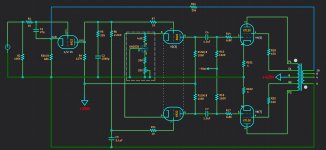I'm not a fan of bypass caps and they can change the sound of the amp, not always for the better. I'd try the amp without them first, if it sounds good just leave them out.The last question I had, if anyone wants to chime in, was about the 0.01uf bypass capacitors, which honestly, I don't even really care about enough to keep the thread open.
I'm just gonna put some vishay 0.01uf 1000v caps in there instead and call it good.
Hey Stephe, love your youtube channel 🙂 I comment sometimes, love watching you build amps.I'm not a fan of bypass caps and they can change the sound of the amp, not always for the better. I'd try the amp without them first, if it sounds good just leave them out.
I've never been a huge believer in capacitor sonics, though I do like things that are well made and good quality, so I usually don't mind spending a few dollars on decent caps. I've been considering getting a couple of Jantzen z caps for the interstage couplers.
As far as the bypass caps, I probably will pull most of them, at least the ones in the audio areas. There's a couple in the power supply sections in positions that I probably won't mess with unless they read funny. (pic)
Attachments
In a push pull output stage that shares a current lol resistor, I.E both tube cathodes are together, and then share a 0.5 ohm resistor to ground (A) there's no issue with changing it to 2 resistors (B) so the current can be seen individually?
That's not going to make it upset, right? If the cathodes aren't directly connected to each other anymore?
It will work, but Dyna said there is some distortion deduction with the common connection that shares a resistor.
If I'm being honest, half of the reason I've started getting into tube amps is I like a bit of distortion, so as long as it's not terrible, I'm good with it. 1-2% is probably fine for me.It will work, but Dyna said there is some distortion deduction with the common connection that shares a resistor.
This amp will eventually get individual bias adjustments for the outputs at the very least. I'm having a great deal of fun tinkering with it and using it as a learning platform, so it might end up with qi boards or arduino management..who knows.
How critical is C2? This is currently a pair of polystyrene capacitors, 1000pF and 560pF. It would be convenient for it to be a single capacitor.
I should be able to put a 1600pF in there, right?

I should be able to put a 1600pF in there, right?
Last edited:
Citation please. This cathode resistor is certainly in series.Tektronix: "A shunt resistor is a precision component inserted within a circuit to measure current."
the meter is in parallel with the resistor. It's there because it loves meters. see?Citation please. This cathode resistor is certainly in series.
I should have included it in my post. Here it is: https://www.tek.com/en/blog/measuring-current-using-shunt-resistorsCitation please. This cathode resistor is certainly in series.
Of course it is. But it's called a shunt resistor in this case to specify it's simply there to allow for current to be measured and serves no other purpose.Citation please. This cathode resistor is certainly in series.
So you are placing it there because you want to know the voltage at that point (voltage measurement) or the amount of current flowing (current measurement)? Which one are you interested in knowing...
A few more links from people who manufacture parts.
https://www.rohm.com/electronics-basics/resistors/shunt-resistors
https://eepower.com/resistor-guide/resistor-applications/shunt-resistor/#
https://uk.rs-online.com/web/content/discovery/ideas-and-advice/shunt-resistors-guide
https://ti.com/video/6076324596001
A few more links from people who manufacture parts.
https://www.rohm.com/electronics-basics/resistors/shunt-resistors
https://eepower.com/resistor-guide/resistor-applications/shunt-resistor/#
https://uk.rs-online.com/web/content/discovery/ideas-and-advice/shunt-resistors-guide
https://ti.com/video/6076324596001
Sorry, it's my fault, I got used to calling anything I put a meter across to measure current using the drop in mV across a resistance, I call it a shunt. I'm sorry if it's not technically correct, I'm very very sorry for opening my yap, look, I even had them change the thread title...it'll never happen again, I apologize, I'll do three hail mary's and a stations of the cross, ok?
I'm over here learning how to wire wrap for fun while youse all arguing about whether a resistor is in series or parallel 😛

So you are placing it there because you want to know the voltage at that point .....?
Yes, don't you? I set my meter to the voltage range and get a number to put in the calculator.
I'm over here learning how to wire wrap for fun while youse all arguing about whether a resistor is in series or parallel 😛
Whiles you was doin' that, I was gettin' me some beers and watchin' foootball. Hope you don't ever have to take that back apart for sumthin.
Me too, it's mostly transformer leads, so if one of them needs to come out, we've got bigger problems lolHope you don't ever have to take that back apart for sumthin.
- Home
- Amplifiers
- Tubes / Valves
- ARC VT60 - Asking lots of questions

